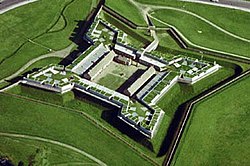Fort Stanwix National Monument
|
Fort Stanwix National Monument
|
|

Aerial view of Fort Stanwix National Monument
|
|
| Location | 112 E. Park St., Rome, NY |
|---|---|
| Coordinates | 43°12′38″N 75°27′18.9″W / 43.21056°N 75.455250°WCoordinates: 43°12′38″N 75°27′18.9″W / 43.21056°N 75.455250°W |
| Area | 16 acres (6.5 ha) |
| Built | 1758 |
| Visitation | 84,933 (2002) |
| Website | www |
| NRHP Reference # | 66000057 |
| Significant dates | |
| Added to NRHP | October 15, 1966 |
| Designated NHL | November 23, 1962 |
| Designated NMON | August 21, 1935 |
Fort Stanwix National Monument is a United States National Historic Site in Rome, New York, managed by the National Park Service (NPS). The current fort is a reconstruction of the historic Fort Stanwix occupying approximately 16 acres (6.5 ha) of downtown Rome. The fort site—although not the reconstruction itself—is listed in the National Register of Historic Places.
Fort Stanwix is historically significant because of its successful defense by American troops during an August 1777 siege. The fort had been built by the British in 1758 at a strategic site along the water route from Lake Ontario to the Hudson River. After American forces captured and rebuilt the fort during the American Revolutionary War, they were besieged by a British army that invaded from Canada via Lake Ontario, hoping to reach the Hudson River. The British force abandoned the siege, a consequence that helped lead to the defeat of a larger British army during the Saratoga campaign.
Fort Stanwix was also the site of the 1768 Treaty of Fort Stanwix between Britain and Native American tribes, as well as of the 1784 Treaty of Fort Stanwix between the tribes and the American government.
Besides the fort reconstruction itself, the national monument includes three short trails that encircle it, one of which follows a portion of the Oneida Carry. The Marinus Willett Collections Management and Education Center preserves the monument’s 485,000 artifacts and documents, displays exhibits about Fort Stanwix and the Mohawk Valley, and serves as a regional tourism center.
President Franklin D. Roosevelt signed enabling legislation that created the national monument on August 21, 1935; at that time, the land that would ultimately be used for the monument was occupied by the businesses and residences of downtown Rome. During the 1960s, Rome city leaders lobbied for a fort reconstruction as part of an urban renewal program to help revitalize downtown Rome. Under political pressure from Senator Robert Kennedy (D-NY), who was seeking political support in upstate New York, the Park Service reluctantly agreed to build a reconstruction of the Revolutionary War-era fort.
...
Wikipedia


